
Salinity and Ocean Circulation
Salinity and Dissolved Substances
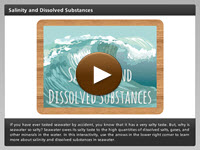 If you have ever tasted seawater by accident, you will remember that it has a very salty taste. But, why is seawater so salty? What elements are found in seawater that are not found in fresh water? Why do some areas of the ocean have a higher salinity when compared to others? View this presentation to learn about salinity and the factors that affect the salt content of the oceans. Click the player button to begin.
If you have ever tasted seawater by accident, you will remember that it has a very salty taste. But, why is seawater so salty? What elements are found in seawater that are not found in fresh water? Why do some areas of the ocean have a higher salinity when compared to others? View this presentation to learn about salinity and the factors that affect the salt content of the oceans. Click the player button to begin.
View a printable version of the interactivity.
Surface Currents

Image Credit: NOAA
Water moves by way of a current, which are mass flows of water. Surface currents are caused by wind blowing in the same direction over long periods of time. The continents surrounding the oceans do not allow the water to travel in the same direction. This forces the currents into giant circles, or gyres. As you can see in the world’s surface current diagram above, there are five ocean gyres: the North Atlantic, North Pacific, South Atlantic, South Pacific, and South Indian. The only current that does not form into a gyre is the Antarctic Circumpolar Current.
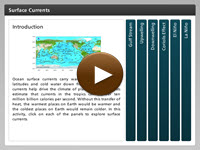 Many oceanographers find it interesting that the term Oceanus (Okeanos) is Latin for river, not ocean. The word dates back to Greek times when mariners encountered the Canary current off of the coast of Western Europe. That is how currents function - like rivers of moving water. However, these rivers are moving through the oceans. Where do ocean currents run? What impact do they have on the climate of our planet? View the presentation to learn more about surface ocean currents and their formation. Click the player button to begin.
Many oceanographers find it interesting that the term Oceanus (Okeanos) is Latin for river, not ocean. The word dates back to Greek times when mariners encountered the Canary current off of the coast of Western Europe. That is how currents function - like rivers of moving water. However, these rivers are moving through the oceans. Where do ocean currents run? What impact do they have on the climate of our planet? View the presentation to learn more about surface ocean currents and their formation. Click the player button to begin.
View a printable version of the interactivity.
Deep Ocean Circulation
Unlike the surface currents, deep ocean currents are not powered by wind at all. Deep water movement is fueled by differences in density of ocean water. Density differences in the ocean are primarily caused by two major factors: water temperature and salinity. Ninety percent of the ocean’s water lies below the surface, and deep water currents continuously move this massive amount of water.
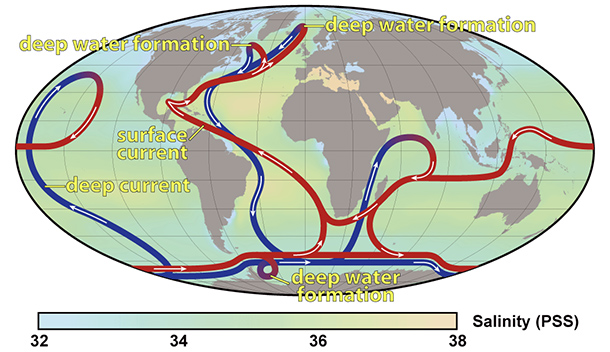
Map showing surface currents, deep ocean currents, and deep water formation.
Oceans contain salt and have different temperatures of water. Both these things cause the ocean water to move. Thermohaline circulation is water motion caused by differing water densities. Just like the convection currents in the atmosphere, warm air rises, cools, and sinks. Convection currents occur as the ocean water becomes cold or salty and sinks down. If cold water is sinking in one place, it has to be rising in another. When this cold, salty water sinks, it is replaced with an upward flow. This movement is called thermohaline circulation. Thermohaline circulation causes all of the surface ocean currents and deep water ocean currents to connect. The oceanic conveyor belt is the term given to this series of interconnected currents that redistribute heat around the globe. This conveyor belt is easy viewed in the image above. All of the deep water currents and surface currents are connected in a slow-moving conveyor belt. Imagine you were a single water molecule floating in this current. It would take thousands of years to travel the world's oceans on this conveyor belt.
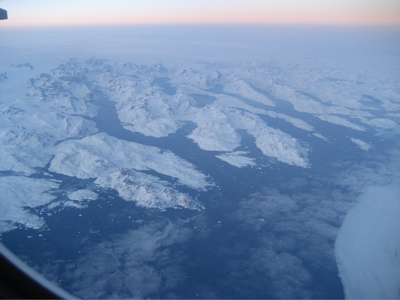 Oceanographers discovered that the oceans' deep and surface currents are connected. If anything was to stop the motion of one current, the whole belt could stop. This might send areas into an ice age, or change the way that heat is distributed in the oceans. Some oceanographers believe when Greenland’s ice melts, it will stop the water from returning to the deep. This event could shut down the conveyor belt. A resulting ice age would ensue as warm water would no longer be distributed to the North Atlantic. Stopping the warm water would send Europe into an ice age. In this situation, global warming could lead to extreme cooling.
Oceanographers discovered that the oceans' deep and surface currents are connected. If anything was to stop the motion of one current, the whole belt could stop. This might send areas into an ice age, or change the way that heat is distributed in the oceans. Some oceanographers believe when Greenland’s ice melts, it will stop the water from returning to the deep. This event could shut down the conveyor belt. A resulting ice age would ensue as warm water would no longer be distributed to the North Atlantic. Stopping the warm water would send Europe into an ice age. In this situation, global warming could lead to extreme cooling.
Salinity and Ocean Circulation Review
![]()
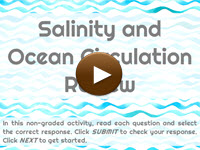 Now that you have explored salinity and ocean circulation, practice what you have learned. In this non-graded activity, read each question and select the correct response. Click the player button to get started.
Now that you have explored salinity and ocean circulation, practice what you have learned. In this non-graded activity, read each question and select the correct response. Click the player button to get started.


